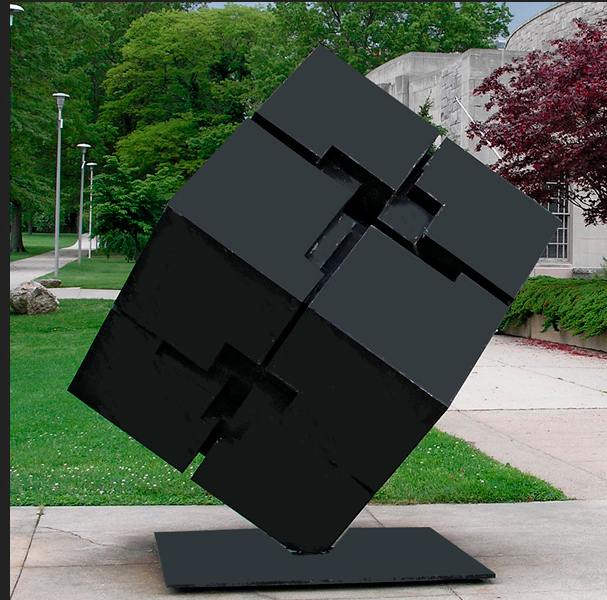Tony Rosenthal, Memorial Cube, 1972
Painted Aluminum, 7 1/2 x 7 1/2 x 7 1/2 feet
© 2020 Estate of Tony Rosenthal / Licensed by VAGA at Artists Rights Society (ARS), New York
Bernard (Tony) Rosenthal (1914-2009) was an American-born Abstract Expressionist sculptor best known for his Monumental Public Art Sculptures. In his mid-twenties, he was commissioned to create a figurative sculpture for the 1939 World’s Fair in New York. At the turn of the century, Rosenthal’s art dealer, Sam Kootz, encouraged him to abandon his concentration on figurative works and shift his focus towards creating abstract, geometric forms. This new approach led him to create some of his most significant outdoor sculptures that can be found in cities including Los Angeles, Miami, New York, Philadelphia and San Diego. Often seen in public spaces, such as Astor Place in Manhattan where Alamo (1967) stands visible, Rosenthal’s prominent works grab the attention of passersby.
At Connecticut College, Memorial Cube (1972) sits perched on the northwest side of the Cummings Arts Center patio near the main entrance. Many walk by this seven-foot-tall steel cube on their way to class, but few take a moment to push it into a spinning revolution. Although Rosenthal intended for the public to interact with his work, the current condition of Memorial Cube (1972) calls for conservation. The piece was donated to Connecticut College in honor of Dene Laib Ulin ’52 and has notable iconic value, listed as a high priority to the College in recent conservation reports.
The company Sculpture and Decorative Arts Conservation Services LLC assessed the sculpture’s condition in 1994 as “good” and in 2009, the last time it was examined, listed it as “poor.” Much of the paint has flaked and a growth of lichen is present on nearly every surface. The base has changed color from black to green, indicating algae growth and corrosion. The company recommends, “the sculpture should be gently washed with a nonionic detergent once per year, dried, inspected for deterioration, the paint consolidated if necessary and waxed.” Four years later, The Cube (1972) still exists in this condition. When spun, a deep rumbling noise is evidence of its age and decaying condition.
This sculpture column is the product of Paige Miller’s ’14 Museum Studies Certificate Program project. For each issue of The College Voice, an article will feature information on an outdoor sculpture on campus. She hopes to highlight the importance of these works and share details about who made them and in what conservation condition they currently exist.









